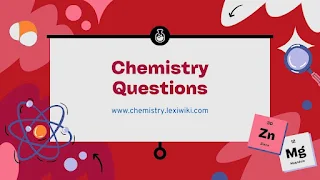Questions on Molar Mass of a Gas
Molar Mass of a Gas – Multiple Choice Questions
1. What is the definition of molar mass?
A) Mass per liter
B) Mass per molecule
C) Mass per mole
D) Volume per gram
E) Atoms per gram
2. Which unit is commonly used for molar mass?
A) kg/L
B) g/L
C) g/mol
D) mol/g
E) L/mol
3. Which equation allows you to calculate the molar mass using the Ideal Gas Law?
A) M = dRT/P
B) M = PRT/V
C) M = RT/P
D) M = PV/nT
E) M = VRT/P
4. In the formula M = dRT/P, what does "d" stand for?
A) Density
B) Distance
C) Diameter
D) Displacement
E) Derivative
5. What is the molar mass of oxygen gas (O₂)?
A) 8 g/mol
B) 16 g/mol
C) 32 g/mol
D) 64 g/mol
E) 28 g/mol
6. What is the molar mass of carbon dioxide (CO₂)?
A) 12 g/mol
B) 16 g/mol
C) 28 g/mol
D) 44 g/mol
E) 22 g/mol
7. If 2.0 g of a gas occupies 1.00 L at STP, what is its molar mass?
A) 22.4 g/mol
B) 44.8 g/mol
C) 2.0 g/mol
D) 48.0 g/mol
E) 20.4 g/mol
8. What is the volume (in L) occupied by 1 mole of an ideal gas at STP?
A) 1.00 L
B) 22.4 L
C) 273 L
D) 44.8 L
E) 0.0821 L
9. If a gas has a density of 1.43 g/L at STP, what is its molar mass?
A) 1.43 g/mol
B) 22.4 g/mol
C) 28.0 g/mol
D) 31.0 g/mol
E) 18.0 g/mol
10. Which of the following is not needed to calculate molar mass using PV = nRT?
A) Pressure
B) Volume
C) Temperature
D) Mass of the sample
E) Color of the gas
11. The formula M = (mRT)/(PV) includes which variable m?
A) Moles
B) Mass of gas
C) Density
D) Molecular size
E) Volume
12. What is the molar mass of nitrogen gas (N₂)?
A) 14 g/mol
B) 28 g/mol
C) 44 g/mol
D) 32 g/mol
E) 16 g/mol
13. To find the molar mass from gas data, which must be known?
A) Mass and volume of the gas
B) Color and smell of the gas
C) Mass and color only
D) Volume and melting point
E) Boiling point and pressure
14. If a gas has a mass of 3.00 g, occupies 1.5 L at 298 K and 1 atm, what is its molar mass?
A) 36.5 g/mol
B) 48.9 g/mol
C) 49.0 g/mol
D) 40.8 g/mol
E) 32.2 g/mol
15. What is the molar mass of helium (He)?
A) 2.0 g/mol
B) 4.0 g/mol
C) 1.0 g/mol
D) 8.0 g/mol
E) 10.0 g/mol
16. What is the main difference between molecular mass and molar mass?
A) Units
B) Mass per molecule vs. per mole
C) Use in liquids vs. gases
D) One uses Celsius
E) None; they are identical
17. Why is it important to use Kelvin in molar mass gas calculations?
A) It’s a scientific tradition
B) Kelvin allows for proper proportionality
C) Celsius causes errors at low temperatures
D) Kelvin avoids negative temperatures
E) All of the above
18. If the density of a gas is known, which variables are needed to find molar mass using M = dRT/P?
A) T and P
B) T, P, and d
C) Only d
D) V and m
E) R only
19. What does molar mass tell us about a gas?
A) How fast it reacts
B) The number of atoms
C) The mass of one mole of its particles
D) The pressure it produces
E) Its temperature behavior
20. The density of an unknown gas is 1.25 g/L at 300 K and 1 atm. What is the molar mass? (Use R = 0.0821 L·atm/mol·K)
A) 30.8 g/mol
B) 25.5 g/mol
C) 20.3 g/mol
D) 18.0 g/mol
E) 15.0 g/mol
Answers with Explanations
1. C – Molar mass is the mass of one mole of a substance.
2. C – It is expressed in grams per mole (g/mol).
3. A – The rearranged form M = dRT/P relates molar mass to density.
4. A – d represents density (mass/volume).
5. C – O₂ has two oxygen atoms: 2 × 16 = 32 g/mol.
6. D – CO₂ = 12 (C) + 2 × 16 (O) = 44 g/mol.
7. A – If 2 g occupies 1 L, then 1 mol = 2 × 22.4 = 44.8 g/mol.
8. B – At STP, 1 mol = 22.4 L for an ideal gas.
9. C – M = d × 22.4 → 1.43 × 22.4 ≈ 28.0 g/mol.
10. E – The color is not a variable in the calculation.
11. B – m is the mass of the gas in grams.
12. B – N₂ = 2 × 14 = 28 g/mol.
13. A – Both mass and volume are required to relate to molar mass.
14. C – Use M = (mRT)/(PV) = (3.00 × 0.0821 × 298)/(1.5 × 1) ≈ 49.0 g/mol.
15. B – Helium has a molar mass of 4.0 g/mol.
16. B – Molecular mass is per molecule, molar mass is per mole.
17. E – All reasons listed make Kelvin the proper unit for gas calculations.
18. B – You need density, pressure, and temperature.
19. C – Molar mass indicates mass of one mole of particles.
20. A – M = dRT/P = (1.25 × 0.0821 × 300) / 1 ≈ 30.8 g/mol
Dive into the groundbreaking science of neurotransmitters—your brain’s invisible architects—in Chemical Harmony: How Neurotransmitters Shape Our Lives (2025). This meticulously researched book reveals how serotonin, dopamine, GABA, and other brain chemicals silently orchestrate every aspect of your existence, from decision-making and relationships to mental health and emotional resilience.Click here to buy
Share Online!

